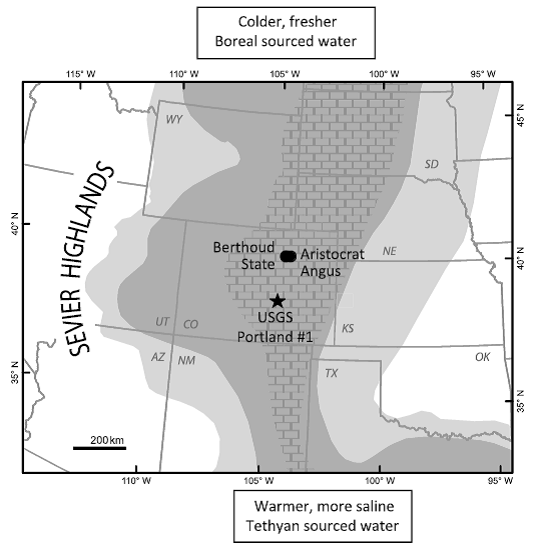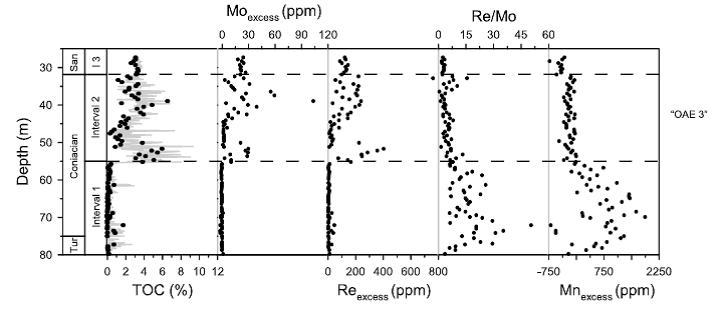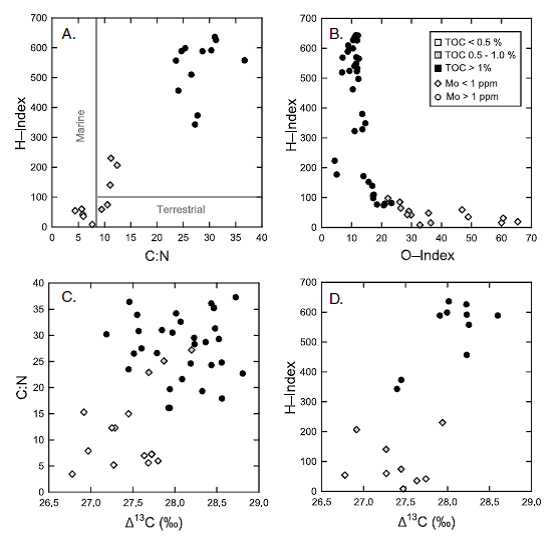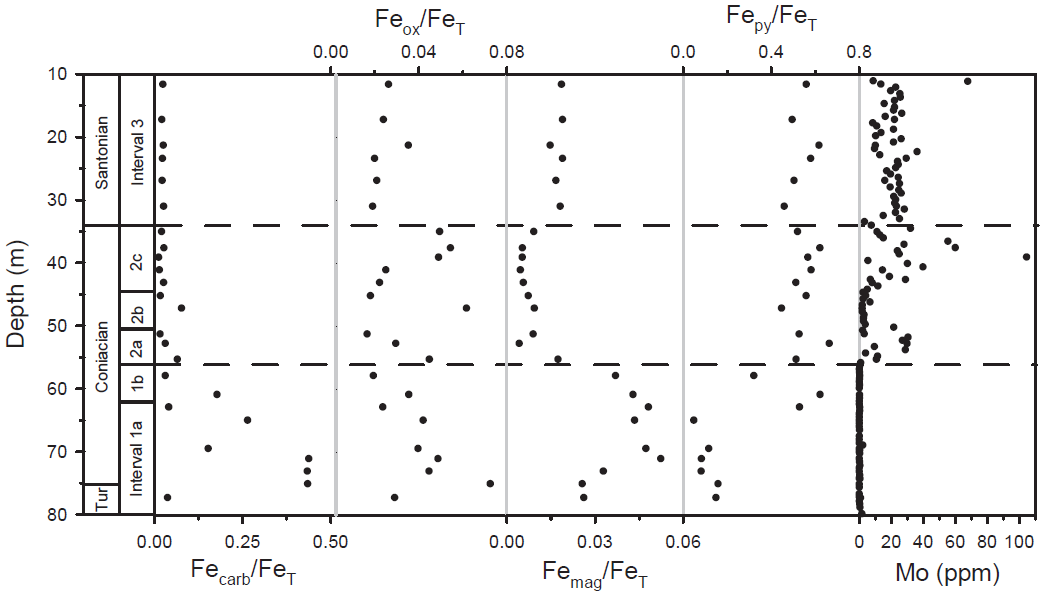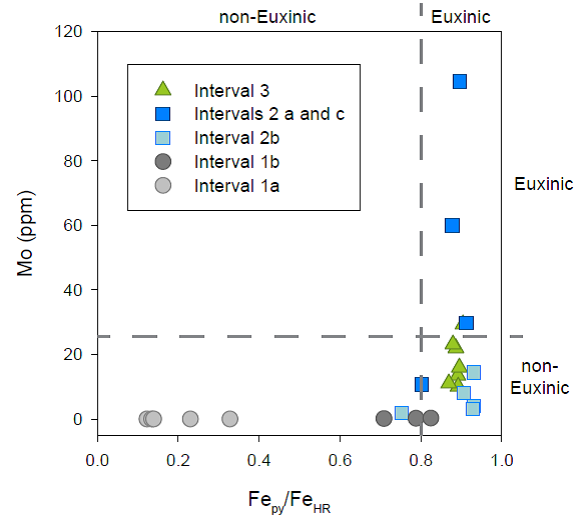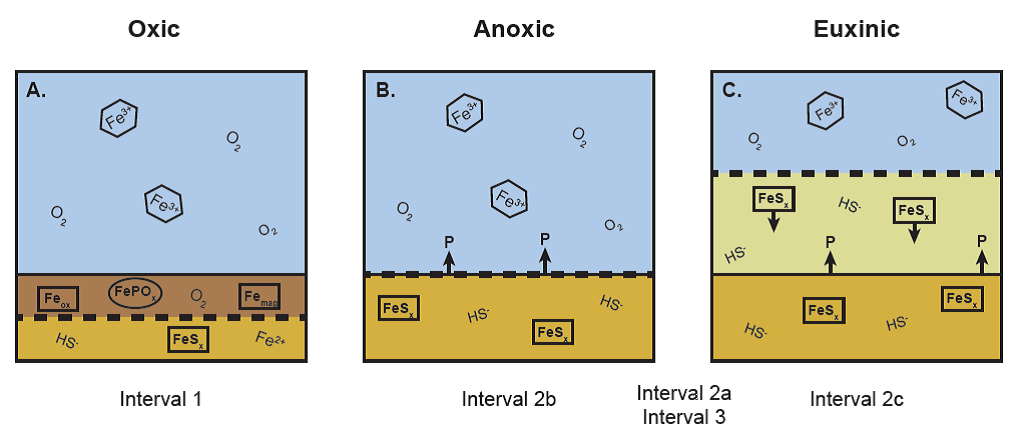Reports: ND853845-ND8: The Role of Sea Level Change in the Spatial and Temporal Distribution of Organic Carbon Accumulation and Bottom Water Redox Conditions in the Cretaceous Niobrara Sea
Nathan D. Sheldon, PhD, University of Michigan
Progress Summary
During the Mesozoic, elevated rates of organic carbon burial resulted in the deposition of organic-rich shales and other sedimentary facies; that burial has typically been associated with extremely low oxygen levels in the water column and has been dubbed “oceanic anoxic events” (OAEs). While it is tantalizing to ascribe a single mechanism to similar geologic events, recent work has indicated that a “one size fits all” model for enhanced carbon burial is not viable. while While carbon burial intensity might be similar between at least some of the Mesozoic OAEs, the duration of the periods of carbon burial varied between 100s of thousands of years to millions of years (OAE 3). This difference impacts the total amount of carbon buried and the preservation of that carbon, as well as raising additional questions about why carbon burial was sustained over so much longer time intervals in some events than in others.
To address these questions, we explored OAE 3 in the Western Interior Seaway (WIS) of North America. OAE 3 spans the Coniacian-Santonian transition and represents the last major period of carbon burial in the Cretaceous. The WIS stretched from the Arctic to Mexico and represented a shallow seaway (Fig. 1).
Figure 1. Map of the WIS during OAE 3.
Interest in the WIS is threefold: 1) to understand carbon burial processes in a “greenhouse” world, 2) to understand the role of climate (if any) in controlling carbon burial in shallow seaways, and 3) because similar rocks are being actively produced for oil and gas in many areas, to understand how the processes that operated in the WIS might have operated in the same or different way as an analogue for how prolonged burial of organic carbon can occur in other times and places. The specific goal of the project was to these the hypothesis that nutrient availability controlled organic carbon production, with bottom water anoxia as a secondary mechanism for burial. In other words, we hypothesized that production would be more important than burial.
We have undertaken fieldwork at a variety of sites in New Mexico, Texas, Colorado, Wyoming, and Montana, and have leveraged those early findings to receive additional funding from National Geographic and from the Turner Research Foundation (UM) and Rackham Graduate School (UM) to add sites in Alberta. Fieldwork and core repository (Fig. 1) collecting has been performed by PI Sheldon, graduate students Allyson Tessin (supported by this award), Timothy Gallagher (not supported), and undergraduate Danielle Boshers (supported).
Figure 2. Carbonate and organic C isotopes from the Portland #1 core during OAE 3.
Early results based on USGS cores indicate that carbon burial in the WIS had three distinct phases (Fig. 2), and that elevated carbon burial lasted at least three millions years. In contrast to our project hypothesis, bottom water redox appears to have been the dominant control. For example, Mo and Re both accumulate under anoxic conditions, whereas Mn accumulates under oxidizing conditions; geochemical analyses clearly show that the onset of carbonate burial corresponds to the shift from oxic to anoxic/euxinic conditions (Fig. 2) and not as a function of nutrients like P (not shown).
Figure 3. Total organic carbon and redox sensitive metal accumulation during OAE 3.
The preservation and “quality” of organic matter also clearly changes both in terms of elemental concentrations, but also Rock-Eval parameters such as the oxygen and hydrogen indices. This shift in the composition of the organic matter itself also reflects the shift to less oxygenated bottom waters, without recording a change in the ultimate source of the organic matter (Fig. 4) or some other extrinsic driver.
Figure 4. Comparison of Rock-Eval parameters with indications of organic matter provenance and carbon isotope fractionation between carbonate and organic phases.
The speciation of Fe-bearing mineral phases follows a similar pattern to Mo (Fig. 5), with more reactive Fe and more pyrite forming during the periods of maximum carbon burial. However, Fe is less sensitive to euxinic conditions (Fig. 6), which suggests that Fe is completely consumed in the WIS during OAE 3, making Fe effectively a limiting nutrient, while simultaneously meaning that because all of the Fe is sequestered, a P excess is possible. This excess of P probably played a key role in prolonging the deposition of organic carbon for so much longer during OAE 3 as compared with other OAEs (Fig. 7).
Figure 5. Breakdown of Fe-bearing minerals into constituent species.
Figure 6. Comparison of Fe reactivity with Mo abundance by stratigraphic interval.
Figure 7. During anoxic and euxinic times, Fe is likely sequestered by sulfide, making it possible for the sediments to re-release P from other Fe-bearing phases that could be re-used for organic matter production, prolonging OAE 3.
Impacts on Project Participants
The project forms the backbone of graduate student Allyson Tessin’s PhD dissertation research. She has published one paper related to the work (reported elsewhere), has one currently in review, and has the data for two additional papers. She is currently applying for post-doctoral positions based on examining carbon burial and redox in modern settings, extending her interest in the field. Undergraduate Danielle Boshers use her work on the project as a springboard to apply for graduate school. She is currently enrolled at UConn, working on a project related to phosphorus and carbon burial in shallow marine settings; again, this is a direct outgrowth from her work on the project. Current undergraduates Becca Dzombak, Sara Leon, and Charlotte Connop are all intending to continue on to graduate school and are learning valuable preparation, analytical, and writing skills as part of this project. For PI Sheldon and co-I Ingrid Hendy, this project has provided an opportunity to collaborate on a project that falls between their respective skill sets. Tessin hasalso leveraged the early results to receive additional funding to expand the scope of the project and PI Sheldon has developed a new collaborative project on younger WIS sediments with UM colleague Selena Smith.

